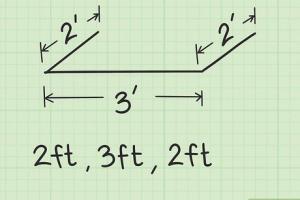Mastering Linear Feet: A Comprehensive Guide to Calculation and Practical Applications

-
Quick Links:
- What is Linear Feet?
- Why Calculate Linear Feet?
- How to Calculate Linear Feet
- Examples of Linear Feet Calculation
- Linear Feet vs Linear Yard
- Applications of Linear Feet
- Common Mistakes in Measuring Linear Feet
- Expert Insights on Linear Measurement
- Case Studies: Real-World Applications
- FAQs
What is Linear Feet?
Linear feet, or lineal feet, is a measurement of length. It is commonly used in construction, flooring, and other applications where length is the primary dimension being measured. One linear foot is equivalent to 12 inches, regardless of the width or height of the material being measured. This unit of measurement simplifies calculations in various fields, including carpentry, landscaping, and interior design.
Why Calculate Linear Feet?
Calculating linear feet is essential for several reasons:
- Material Estimation: Knowing the linear feet of materials helps in estimating costs and quantities needed for projects.
- Space Planning: Linear measurements are crucial in planning layouts for construction, flooring, and landscaping.
- Accurate Ordering: Accurate calculations ensure that the right amount of materials are ordered, reducing waste and saving money.
How to Calculate Linear Feet
Calculating linear feet is straightforward. Follow these steps to ensure accuracy:
- Measure the Length: Use a tape measure to measure the length of the object or area in inches.
- Convert to Feet: Divide the total inches by 12 to convert inches to feet. For example, if you measure 48 inches, divide 48 by 12, resulting in 4 linear feet.
- Account for Multiple Sections: If measuring multiple sections, repeat the process for each and sum the total linear feet.
Examples of Linear Feet Calculation
Let’s explore some practical examples:
- Example 1: A room measures 10 feet long and 8 feet wide. To calculate the linear feet of the perimeter, add all sides: (10 + 10 + 8 + 8) = 36 linear feet.
- Example 2: A fence requires 150 inches of material. To calculate the linear feet, divide 150 by 12, resulting in 12.5 linear feet.
Linear Feet vs Linear Yard
It is essential to understand the difference between linear feet and linear yards:
- Linear Feet: Measures length in feet.
- Linear Yard: Measures length in yards (1 yard = 3 feet).
To convert linear feet to linear yards, divide the number of linear feet by 3. For example, 9 linear feet equals 3 linear yards.
Applications of Linear Feet
Linear feet are widely used in various fields:
- Construction: Used to measure walls, flooring, and roofing materials.
- Landscaping: Helps calculate the amount of edging, fencing, and other landscape materials.
- Interior Design: Essential for measuring curtains, trim, and furniture layouts.
Common Mistakes in Measuring Linear Feet
To avoid errors, keep these common mistakes in mind:
- Not Using a Straight Edge: Ensure the tape measure is straight for accurate readings.
- Ignoring Obstructions: Measure around objects, not through them.
- Failing to Double Check: Always double-check measurements for accuracy.
Expert Insights on Linear Measurement
To gain deeper insights, we consulted experts in construction and design:
"Understanding linear measurement is crucial in avoiding costly mistakes. Always measure twice and cut once," says John Doe, a veteran carpenter.
Case Studies: Real-World Applications
Here are some case studies highlighting linear feet calculations:
- Case Study 1: A homeowner renovated their living room, requiring 120 linear feet of crown molding. Accurate calculations helped them order the precise amount, minimizing waste.
- Case Study 2: A landscaping project involved installing 150 linear feet of fencing. Understanding how to calculate linear feet allowed the contractor to provide an accurate quote.
FAQs
- What is the difference between linear feet and square feet? Linear feet measure length, while square feet measure area.
- How do I convert linear feet to inches? Multiply the number of linear feet by 12.
- Can I measure linear feet in centimeters? Yes, but you will need to convert to feet by dividing by 30.48.
- What tools do I need to measure linear feet? A tape measure or ruler is sufficient.
- How do I calculate linear feet for a curved surface? Use a flexible measuring tape to follow the curve before converting to linear feet.
- Is there a linear feet calculator available online? Yes, many websites offer linear feet calculators for convenience.
- What are common materials measured in linear feet? Wood, flooring, piping, and fencing are commonly measured in linear feet.
- Why is it important to know linear feet in home improvement? It ensures accurate material estimation and budgeting.
- Can I calculate linear feet for irregular shapes? Yes, break down the shape into straight sections and add the lengths.
- How often should I measure for projects? Always measure before purchasing materials to ensure accuracy.
Random Reads